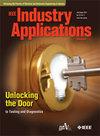Enhancement of Electromagnetic Supporting Force in Aerodynamic Bearing-Equipped SPMSMs
IF 4.5
2区 工程技术
Q2 ENGINEERING, ELECTRICAL & ELECTRONIC
引用次数: 0
Abstract
A high speed surface mounted permanent magnet synchronous motor (SPMSM) equipped with aerodynamic bearings is studied in this paper. Controllable electromagnetic supporting force (EMSF) is produced by the motor armature windings, while electromagnetic torque being simultaneously generated, in order to dilute dry friction in the air bearings before reaching the lift-off speed of the bearings. In this paper, a new method to increase the EMSF density and reduce the EMSF ripples is proposed. Firstly, generation principles of the EMSF and its ripples are introduced. Then, by analyzing the difference between the conventional electromagnetic torque design and the EMSF design, a new method is proposed, increasing the equivalent air gap magnetic permeability to enhance the EMSF density. Then, according to the analysis results of the air gap field spatial harmonic components affecting the EMSF ripples, shaping of the permanent magnets (PMs) and rotor core is conducted. This shaping method is founded on the analytical approach interpreting the influence of rotor parameters on the spatial magnetic field distribution. Utilizing the design method proposed in this paper, an SPMSM system capable of generating controllable EMSF is developed. Finite element analysis (FEA) and experimental study are carried out to demonstrate the improvement in EMSF density and the reduction in EMSF ripples, thereby proving the feasibility of the design method proposed.增设气动轴承的永磁同步电动机电磁支撑力增强研究
研究了一种采用气动轴承的高速表面贴装永磁同步电动机。可控电磁支撑力(EMSF)由电机电枢绕组产生,同时产生电磁转矩,以便在达到轴承的升降速度之前稀释空气轴承中的干摩擦。本文提出了一种提高电磁脉冲密度和减小电磁脉冲脉动的新方法。首先,介绍了EMSF及其波纹的产生原理。然后,通过分析传统电磁转矩设计与EMSF设计的差异,提出了通过增加等效气隙磁导率来提高EMSF密度的新方法。然后,根据气隙场空间谐波分量对EMSF波纹的影响分析结果,对永磁体和转子铁芯进行了整形。这种成形方法是建立在解释转子参数对空间磁场分布影响的解析方法的基础上的。利用本文提出的设计方法,研制了一种能够产生可控电磁脉冲的SPMSM系统。通过有限元分析和实验研究,验证了电磁脉冲密度的提高和电磁脉冲脉动的减小,从而验证了所提出设计方法的可行性。
本文章由计算机程序翻译,如有差异,请以英文原文为准。
求助全文
约1分钟内获得全文
求助全文
来源期刊

IEEE Transactions on Industry Applications
工程技术-工程:电子与电气
CiteScore
9.90
自引率
9.10%
发文量
747
审稿时长
3.3 months
期刊介绍:
The scope of the IEEE Transactions on Industry Applications includes all scope items of the IEEE Industry Applications Society, that is, the advancement of the theory and practice of electrical and electronic engineering in the development, design, manufacture, and application of electrical systems, apparatus, devices, and controls to the processes and equipment of industry and commerce; the promotion of safe, reliable, and economic installations; industry leadership in energy conservation and environmental, health, and safety issues; the creation of voluntary engineering standards and recommended practices; and the professional development of its membership.
 求助内容:
求助内容: 应助结果提醒方式:
应助结果提醒方式:


